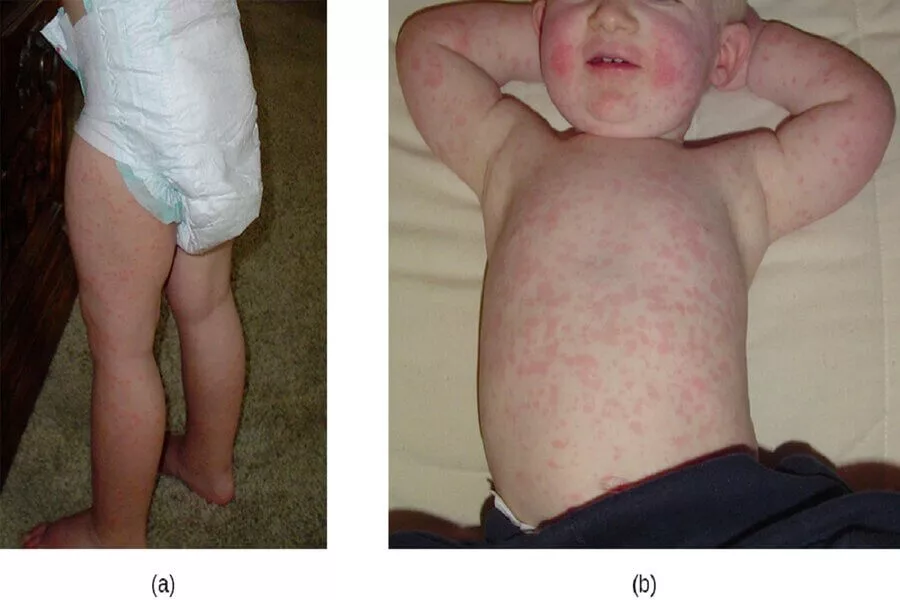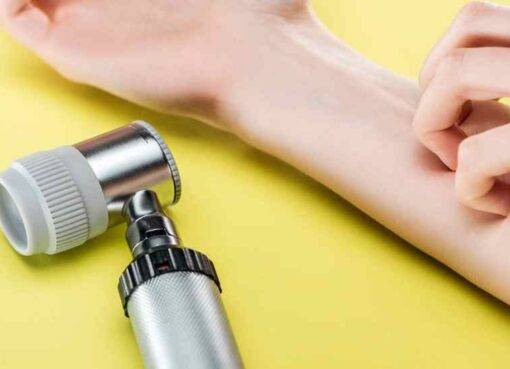What is Roseola
Roseola is a virus-borne disease that is very infectious. It’s also known as the sixth disease since the human herpesvirus (HHV) type 6 is the most common cause of the illness, and it lasts for around 6 days. It begins with a fever and is followed by a distinctive skin rash.
It inevitably involves a minor illness that affects children by the age of two. Roseola is so prevalent that almost every child has gotten infected by this disease by the time the kids start kindergarten.
Some children only have a minor case of roseola and never show any signs or symptoms of disease, while others get the entire spectrum of symptoms.
Roseola isn’t usually taken seriously. An extremely high temperature might cause problems in rare cases.
Symptoms
If your kid is exposed to someone who has roseola and becomes infected with the virus, signs, and symptoms of illness usually take a week or two to develop if they appear at all.
It is possible to become infected with roseola yet have symptoms that are too minor to be noticed. Fever is a typical sign of roseola.
Roseola is characterized by
- Fever – The high temperature commonly exceeds 103 degrees Fahrenheit. A running nose, cough, or sore throat can accompany or precede the fever in some kids. Along with the fever, your kid may develop enlarged lymph nodes in his or her neck. The fever might persist anywhere from three to five days.
- Rash – A rash usually emerges after the fever has subsided, but this is not always the case. Many tiny pink dots or patches make up the rash. The majority of these areas are flat, although some may be elevated. Some of the dots may have a white ring around them. The rash often begins on the chest, back, and abdomen, spreading to the neck and arms. The legs and face may or may not be affected. The rash, which is not painful nor unpleasant, can persist anywhere from a few hours to several days until it fades.
Roseola can also cause the following signs and symptoms:
- Irritability in babies and children
- Mild diarrhea
- Decreased appetite
- Swollen eyelids
- Runny nose
- Sore throat
The child’s fever begins to subside 2 to 4 days after being ill, and a rash emerges.
The most common features of this rash are that it starts in the center of the body and extends to the arms, legs, neck, and face. It is pink or reddish colored, with small, slightly raised blisters
The rash might persist anywhere from a few hours to two to three days. It doesn’t typically itch.
The roseola skin rash is sometimes confused with the measles skin rash. However, measles rashes are very different.
The rash of measles is red or brownish-red in color. It generally begins on the face and progresses down the body, eventually covering the entire body in bumpy patches.
The roseola rash is pinkish in appearance and usually begins on the belly before spreading to the face, arms, and legs.
When a child has roseola, they usually feel better once the rash emerges. A kid with measles, on the other hand, may feel ill even if the rash isn’t visible.
Causes
Human herpesvirus 6 is the most prevalent cause of roseola, however, it can also be caused by another herpes virus, human herpesvirus 7.
Roseola takes around 14 days to incubate.
Roseola spreads from person to person by contact with an infected individual’s respiratory secretions or saliva, just like other viral diseases like the common cold.
Even if there is no rash, roseola is infectious. That implies the disease can spread even if a kid is merely sick with a fever and hasn’t yet been diagnosed with roseola.
If your kid has interacted with a peer who has the condition, keep an eye out for indications of roseola.
Unlike chickenpox and other fast-spreading childhood viral diseases, roseola seldom causes a community-wide outbreak. Infections can strike at any time of year.
Roseola’s symptoms are similar to those of other common pediatric illnesses, making them difficult to diagnose.
It is generally detected after the fever has passed and your kid is feeling better because the fever comes and goes before the rash emerges.
Potential danger
Because they haven’t had enough time to produce their own antibodies against many viruses, older newborns are at the greatest risk of contracting roseola.
Babies get antibodies from their mothers while still in the uterus, protecting them from diseases like roseola.
This immunity, however, deteriorates with time. Roseola is most commonly contracted when a kid is between the ages of 6 and 15 months.
Prevention
Because there is no vaccination to prevent roseola, the best way to prevent it from spreading is to keep your child away from an affected child.
If your child has roseola, confine him or her to the house and keep him or her away from other children until the fever has subsided.
By the time they reach school age, most people have developed antibodies against roseola, rendering them resistant to a second infection.
Even so, if one member of the home catches the virus, make sure that everyone in the family washes their hands often to prevent the infection from spreading to anyone who isn’t immune.
Adults with Roseola
Adults who were never infected as children can get roseola later in life, although the illness is often moderate in healthy adults.
Infected adults, on the other hand, can transmit the virus to kids or babies.
Roseola can be contracted more than once, although this is uncommon unless the person’s immune system is weakened.
Diagnosis
Because roseola’s early signs and symptoms are similar to those of other common pediatric diseases, it can be difficult to identify.
If your kid has a fever but no cold, ear infection, strep throat, or other common illness is evident, your doctor may decide to wait to see if the roseola rash emerges.
While treating your child’s fever at home, your doctor may advise you to keep an eye out for the rash.
Treatment
Doctors do not prescribe medicines for roseola since it is caused by a virus. Antibiotics are only effective against bacteria-related diseases.
Within a week of the beginning of the fever, most kids recover completely from roseola.
To assist in decreasing fever and relieve discomfort, your doctor may advise you to give your kid over-the-counter medications such as acetaminophen (Tylenol) or ibuprofen (Advil, Motrin).
Caution
When administering aspirin to adolescents or teens, use care. Children and teens suffering from chickenpox or flu-like symptoms should never use aspirin, even though it is allowed for use in children over the age of three.
This is because aspirin has been linked to Reye’s syndrome in children, a rare but potentially deadly illness.
Reye’s syndrome is an uncommon yet life-threatening disease that involves liver and brain enlargement. Reye’s syndrome is most common in children and babies who have just recovered from a viral infection such as roseola, flu, or chickenpox.
Physicians may prescribe the antiviral medication ganciclovir (Cytovene) to treat roseola in children or people with a compromised immune system.
Dress your kid in cool attire, give them a sponge bath, or give them cool snacks like popsicles to help keep them comfortable.
Homecare
Roseola, like other infections, simply needs to run its course. Your loved one should feel much better once the fever has subsided. Your doctor may advise you to perform the following at-home treatment to cure your child’s fever:
- Get plenty of sleep. Allow your child to remain in bed until the fever has subsided.
- Drink plenty of water. Encourage your child to consume clear fluids such as water, lemon-lime soda, clear broth, or an electrolyte rehydration solution.
- Baths with sponges. A cold washcloth rubbed on your child’s head or a lukewarm sponge bath might help to relieve the pain of a fever.
Recovery
When your kid has been fever-free for at least 24 hours and has no other symptoms, he or she can resume normal activities.
Roseola is contagious when a child has a fever, but it is not contagious when they only have a rash.
If someone in your household has roseola, it’s critical to wash your hands regularly to prevent the infection from spreading.
Make sure your child gets adequate rest and stays hydrated to aid with their recovery.
The majority of children recover within a week after the onset of a fever.
Citation
https://www.ncbi.nlm.nih.gov/books/NBK448190/
https://www.mayoclinic.org/diseases-conditions/roseola/diagnosis-treatment/drc-20377289
https://medlineplus.gov/ency/article/000968.htm
https://www.healthline.com/health/roseola#recovery
https://my.clevelandclinic.org/health/diseases/15785-roseola-infantumsixth-disease
Featured photo:https://shorturl.at/pyFIR





Can you be more specific about the content of your article? After reading it, I still have some doubts. Hope you can help me. https://www.binance.info/uk-UA/join?ref=P9L9FQKY
Your article helped me a lot, is there any more related content? Thanks! https://accounts.binance.com/cs/register?ref=B4EPR6J0
Thanks for sharing. I read many of your blog posts, cool, your blog is very good. https://accounts.binance.com/sk/register-person?ref=OMM3XK51
Can you be more specific about the content of your article? After reading it, I still have some doubts. Hope you can help me. https://www.binance.info/bg/join?ref=PORL8W0Z
Thank you for your sharing. I am worried that I lack creative ideas. It is your article that makes me full of hope. Thank you. But, I have a question, can you help me? https://www.binance.com/sk/register?ref=PORL8W0Z
Thank you for your sharing. I am worried that I lack creative ideas. It is your article that makes me full of hope. Thank you. But, I have a question, can you help me?
Wow, fantastic weblog format! How long have you ever been blogging for?
you make blogging glance easy. The overall look of your site is great, let
alone the content material! You can see similar here sklep